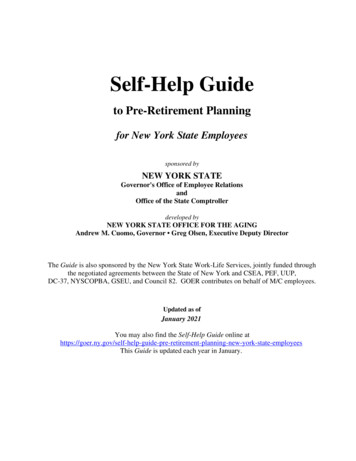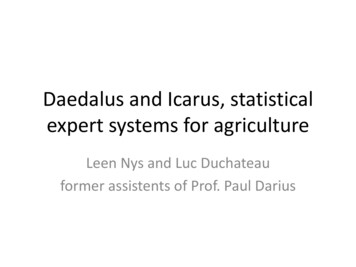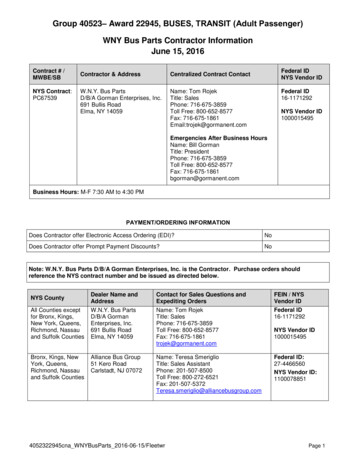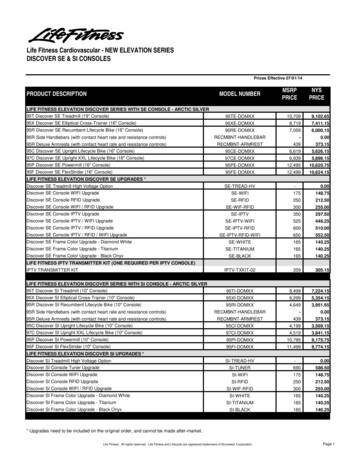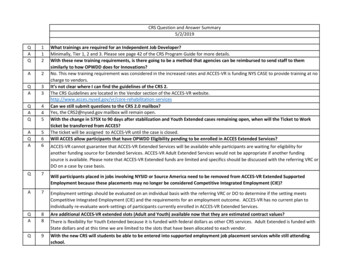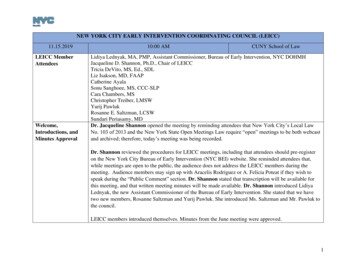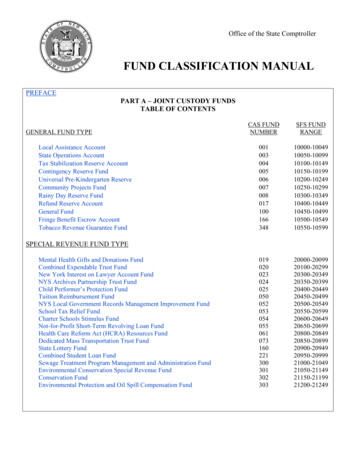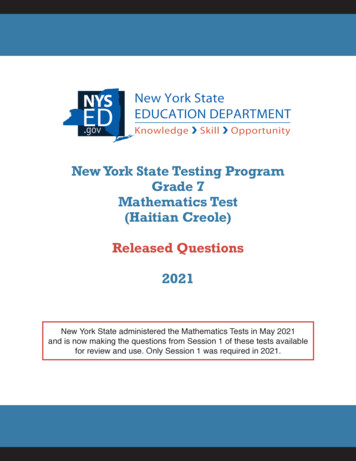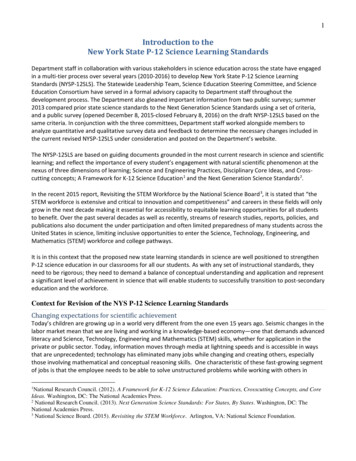
Transcription
1Introduction to theNew York State P-12 Science Learning StandardsDepartment staff in collaboration with various stakeholders in science education across the state have engagedin a multi-tier process over several years (2010-2016) to develop New York State P-12 Science LearningStandards (NYSP-12SLS). The Statewide Leadership Team, Science Education Steering Committee, and ScienceEducation Consortium have served in a formal advisory capacity to Department staff throughout thedevelopment process. The Department also gleaned important information from two public surveys; summer2013 compared prior state science standards to the Next Generation Science Standards using a set of criteria,and a public survey (opened December 8, 2015-closed February 8, 2016) on the draft NYSP-12SLS based on thesame criteria. In conjunction with the three committees, Department staff worked alongside members toanalyze quantitative and qualitative survey data and feedback to determine the necessary changes included inthe current revised NYSP-12SLS under consideration and posted on the Department’s website.The NYSP-12SLS are based on guiding documents grounded in the most current research in science and scientificlearning; and reflect the importance of every student’s engagement with natural scientific phenomenon at thenexus of three dimensions of learning; Science and Engineering Practices, Disciplinary Core Ideas, and Crosscutting concepts; A Framework for K-12 Science Education 1 and the Next Generation Science Standards 2.In the recent 2015 report, Revisiting the STEM Workforce by the National Science Board 3, it is stated that “theSTEM workforce is extensive and critical to innovation and competitiveness” and careers in these fields will onlygrow in the next decade making it essential for accessibility to equitable learning opportunities for all studentsto benefit. Over the past several decades as well as recently, streams of research studies, reports, policies, andpublications also document the under participation and often limited preparedness of many students across theUnited States in science, limiting inclusive opportunities to enter the Science, Technology, Engineering, andMathematics (STEM) workforce and college pathways.It is in this context that the proposed new state learning standards in science are well positioned to strengthenP-12 science education in our classrooms for all our students. As with any set of instructional standards, theyneed to be rigorous; they need to demand a balance of conceptual understanding and application and representa significant level of achievement in science that will enable students to successfully transition to post-secondaryeducation and the workforce.Context for Revision of the NYS P-12 Science Learning StandardsChanging expectations for scientific achievementToday’s children are growing up in a world very different from the one even 15 years ago. Seismic changes in thelabor market mean that we are living and working in a knowledge-based economy—one that demands advancedliteracy and Science, Technology, Engineering and Mathematics (STEM) skills, whether for application in theprivate or public sector. Today, information moves through media at lightning speeds and is accessible in waysthat are unprecedented; technology has eliminated many jobs while changing and creating others, especiallythose involving mathematical and conceptual reasoning skills. One characteristic of these fast-growing segmentof jobs is that the employee needs to be able to solve unstructured problems while working with others in1National Research Council. (2012). A Framework for K-12 Science Education: Practices, Crosscutting Concepts, and CoreIdeas. Washington, DC: The National Academies Press.2National Research Council. (2013). Next Generation Science Standards: For States, By States. Washington, DC: TheNational Academies Press.3National Science Board. (2015). Revisiting the STEM Workforce. Arlington, VA: National Science Foundation.
2teams. At the same time, migration and immigration rates around the world bring diversity to schools andneighborhoods. The exponential growth in interactions and information sharing from around the world meansthere is much to process, communicate, analyze and respond to in the everyday, across all settings. For a greatnumber of jobs, conceptual reasoning and technical writing skills are integral parts to the daily routine.To prepare students for the changes in the way we live and work, and to be sure that our education systemkeeps pace with what it means to be scientifically literate and what it means to collaboratively problem solve,we need a different approach to daily teaching and learning. We need content-rich standards that will serve as aplatform for advancing children’s 21st-century science skills —their abstract reasoning, their collaboration skills,their ability to learn from peers and through technology, and their flexibility as a learner in a dynamic learningenvironment. Students need to be engaged in dialogue and learning experiences that allow complex topics andideas to be explored from many angles and perspectives. They also need to learn how to think and solveproblems for which there is no one solution—and learn science skills along the way.Increasingly Diverse Learner PopulationsThe need for a deeper, more innovative approach to mathematics teaching comes at a time when the system isalready charged with building up language skills among the increasingly diverse population. Students who areEnglish Language Learners (ELLs)/Multilingual Learners (MLLs) now comprise over 20% of the school-agepopulation, which reflects significant growth in the past several decades. Between 1980 and 2009, thispopulation increased from 4.7 to 11.2 million young people, or from 10 to 21% of the school-age population.This growth will likely continue in U.S. schools; by 2030, it is anticipated that 40% of the school-age population inthe U.S. will speak a language other than English at home 4. Today, in schools and districts across the U.S., manystudent’s other than those classified as ELL are learning English as an additional language, even if not in theinitial stages of language development—these children are often described as “language minority learners.”Likewise, many students, large numbers of whom are growing up in poverty, speak a dialect of English that isdifferent from the academic English found in school curriculum 5.Each of these groups—ELLs/MLLs, language minority learners, and students acquiring academic English—oftenstruggle to access the language, and therefore the knowledge that fills the pages of academic texts, despite theirlinguistic assets. Therefore, the context for this new set of Science Standards is that there is a pressing need toprovide instruction that not only meets, but exceeds standards, as part of system-wide initiative to promoteequal access to science skills for all learners while capitalizing on linguistic and cultural diversity.All academic work does, to some degree, involve the academic language needed for success in school. For manystudents, including ELLs/MLLs, underdeveloped academic language affects their ability to comprehend andanalyze texts, limits their ability to write and express their scientific reasoning effectively, and can hinder theiracquisition of academic content in all academic areas in which learning is demonstrated and assessed throughoral and written language. If there isn’t sufficient attention paid to building academic language across all contentareas, students, including ELLs/MLLs, will not reach their potential and we will continue to perpetuate4Camarota, S. (2012). Immigrants in the United States, 2010: A profile of America's foreign-born population. Washington,D.C. Center for Immigration Studies.5Aud, S., Hussar, W., Kena, G., Bianco, K., Frohlich, L., Kemp, J. et al. The condition of education 2011 (NCES 2011-033).Lopez, M. & Velasco, G. The Toll of the Great Recession: Childhood Poverty among Hispanics Sets Record, Leads Nation,report prepared for the Pew Hispanic Center (Washington: Pew Hispanic Center, September 2011). Ryan, C. (2013).Language use in the United States: 2011. American community survey reports, 22, 1-16.
3achievement gaps. The challenge is to design instruction that acknowledges the role of language; becauselanguage and knowledge are so inextricable.In summary, today’s children live in a society where many of their peers are from diverse backgrounds andspeak different languages; one where technology is ubiquitous and central to daily life. They will enter aworkforce and economy that demands critical thinking skills, and strong communication and social skills for fullparticipation in society. This new society and economy has implications for today’s education system—especiallyour instruction to foster a deeper and different set of communication and critical thinking skills, with significantattention to STEM.Students with Disabilities and the StandardsStudents with disabilities must have opportunities to benefit from high quality instruction and to reach the samelearning standards as all students. Under federal and State law, it is a fundamental right of students withdisabilities to not only be taught the same content (the general education curriculum) as other students, butalso to be provided appropriate supports (including accommodations and scaffolding) and services based ontheir individual needs so that they can gain knowledge and skills and demonstrate what they have learned.Each student’s individualized education program (IEP) must be developed in consideration of the State learningstandards and should provide information for teachers to effectively provide supports and services to addressthe individual learning needs of the student as they impact the student’s ability to participate and progress inthe general education curriculum.In addition to supports and services, special education must include specially designed instruction, which meansadapting, as appropriate to the needs of a student with a disability, the content, methodology or delivery ofinstruction to address the unique needs that result from the student’s disability. By so doing, the teacherenables each student’s access to the general education curriculum so that he or she can meet the learningstandards that apply to all students. The Blueprint for Improved Results for Students with Disabilities focuses onseven core evidence-based principles for students with disabilities to ensure they have the opportunity tobenefit from high quality instruction and to reach the same standards as all students. For additional information,please see s-with-disabilities.html.The New York State P-12 Science Learning Standards were developed in collaboration with various stakeholdersin science education to ensure each student’s access to science. To access resources and guidance on how thelearning standards relate to curriculum, instruction and students with disabilities, see the NYSED Office ofSpecial Education website at http://www.p12.nysed.gov/specialed/.Understanding the New York State P-12 Science Learning StandardsThe New York State P-12 Science Learning Performance ExpectationsThe New York State P-12 Science Learning Standards are a series of performance expectations that define whatstudents should understand and be able to do as a result of their study of science. The New York State P-12Science Learning Standards are based on the Framework for K–12 Science Education developed by the NationalResearch Council1 and the Next Generation Science Standards2. The framework outlines three dimensions thatare needed to provide students a high-quality science education. The integration of these three dimensionsprovides students with a context for the content of science, how science knowledge is acquired and understood,and how the sciences are connected through concepts that have universal meaning across the disciplines.
4Dimension 1: Science and Engineering PracticesDimension 1, Science and Engineering Practices, describes (a) the major practices that scientists employ as theyinvestigate and build models and theories about the world and (b) a key set of engineering practices thatengineers use as they design and build systems. The term “practices” is used instead of a term such as “skills” toemphasize that engaging in scientific investigation requires not only skill but also knowledge that is specific toeach practice.Similarly, because the term “inquiry,” extensively referred to in previous standards documents, has beeninterpreted over time in many ways throughout the science education community, part of the intent inarticulating the practices in Dimension 1 is to better specify what is meant by inquiry in science and the range ofcognitive, social, and physical practices that it requires. As in all inquiry-based approaches to science teaching,the expectation is that students will themselves engage in the practices and not merely learn about themsecondhand. Students cannot comprehend scientific practices, nor fully appreciate the nature of scientificknowledge itself, without directly experiencing those practices for themselves.The eight science and engineering practices mirror the practices of professional scientists and engineers. Use ofthe practices in the performance expectations is not only intended to strengthen students’ skills in thesepractices but also to develop students’ understanding of the nature of science and engineering. Listed below arethe eight science and engineering practices from the Framework:1. Asking questions and defining problems2. Developing and using models3. Planning and carrying out investigations4. Analyzing and interpreting data5. Using mathematics and computational thinking6. Constructing explanations and designing solutions7. Engaging in argument from evidence8. Obtaining, evaluating, and communicating informationThe New York State P-12 Science Learning Standards use constructed grade-band endpoints for the science andengineering practices for grades P-5, middle school and high school that are based on progressions and twelfthgrade endpoints. The representations of the science and engineering practices appear in the New York State P12 Science Learning Standards and supporting foundation boxes.Dimension 2: Disciplinary Core IdeasThe continuing expansion of scientific knowledge makes it unrealistic to teach all the ideas related to a givendiscipline in exhaustive detail during the K-12 years. Given the cornucopia of information available todayvirtually at a touch—people live, after all, in an information age—an important role of science education is toprepare students with sufficient core knowledge so that they can acquire additional information on their own asthey need it. An education focused on a limited set of ideas and practices in science and engineering shouldenable students to evaluate and select reliable sources of scientific information, and allow them to continuetheir development well beyond their K-12 school years as science learners, users of scientific knowledge, andperhaps also as producers of such knowledge.The disciplinary core ideas are built on the notion of learning as a developmental progression. They are designedto help children continually build on and revise their knowledge and abilities, starting from their curiosity aboutwhat they see around them and their initial conceptions about how the world works. The goal is to guide theirknowledge toward a more scientifically based and coherent view of the natural sciences and engineering, as wellas of the ways in which they are pursued and their results can be used.
5Dimension 3: Crosscutting ConceptsThe crosscutting concepts have application across all domains of science. As such, they provide one way oflinking across the domains in Dimension 3. These crosscutting concepts are not unique to The Framework. Theyecho many of the unifying concepts and processes in the National Science Education Standards, the commonthemes in the Benchmarks for Science Literacy, and the unifying concepts in the Science College BoardStandards for College Success. They also reflect discussions related to the NSTA Science Anchors project, whichemphasized the need to consider not only disciplinary content but also the ideas and practices that are within allof the science disciplines.The seven Crosscutting Concepts that are meant to give students an organizational structure to understand theworld and help students make sense of and connect Core Ideas across disciplines and grade bands. They are notintended as additional content. Listed below are the Crosscutting Concepts from the Framework:1. Patterns2. Cause and Effect3. Scale, Proportion, and Quantity4. Systems and System Models5. Energy and Matter in Systems6. Structure and Function7. Stability and Change of SystemsThe New York State P-12 Science Learning Standards use constructed grade-band endpoints for the CrosscuttingConcepts for grades P-5, middle school and high school that are based on progressions and twelfth-gradeendpoints. The representations of the Crosscutting Concepts appear in the New York State P-12 Science LearningStandards and supporting foundation boxes.The Standards set student performance expectations among topics but do not define the intervention methodsor materials necessary to support students who are well below or well above grade-level expectations. It is alsobeyond the scope of the Standards to define the full range of supports appropriate for English LanguageLearners (ELLs)/Multilingual Learners (MLLs) and for Students with Disabilities. However, the departmentensured that teachers of English Language Learners (ELLs)/Multilingual Learners (MLLs) and Students withDisabilities participated in the development of the standards. The New York State Education Department(NYSED) has created two statewide frameworks, the Blueprint for Improved Results for Students with Disabilitiesand the Blueprint for English Language Leaner Success, aimed to clarify expectations and to provide guidance foradministrators, policymakers, and practitioners to prepare ELLs/MLLs and Students with Disabilities for success.These principles therein the frameworks are intended to enhance programming and improve instruction thatwould allow for students within these populations to reach the same standards as all students and leave schoolprepared to successfully transition to post school learning, living and working.No set of grade-specific standards can fully reflect the variation in learning profiles, rates, and needs, linguisticbackgrounds, and achievement levels of students in any given classroom. When designing and deliveringscience instruction, educators must consider the cultural context and prior academic experiences of all studentswhile bridging prior knowledge to new knowledge and ensuring that content is meaningful and comprehensible.In addition, as discussed above, educators must consider the relationship of language and content, and the vitalrole that language plays in obtaining and expressing mathematics content knowledge. The Standards should beread as allowing for the widest possible range of students to participate fully from the outset, along withappropriate adaptations to ensure equitable access and maximum participation of all students.
6Organization of the New York State P-12 Science Learning StandardsThe New York State P-12 Science Learning Standards have been written as performance expectations that depictwhat the student must do to show proficiency in science. Science and Engineering Practices were coupled withcomponents of the Disciplinary Core Ideas and Crosscutting Concepts to make up the performance expectations.Science concepts build coherently across K-12. The emphasis of the New York State P-12 Science LearningStandards is a focused and coherent progression of knowledge from grade band to grade band, allowing for adynamic process of building knowledge throughout a student’s entire P-12 science education.The performance expectations are organized by grade level from Prekindergarten through 5th grade and bytopic at the middle and high school level. The highlighted performance expectations are expectations that aredifferent from the Next Generation Science Standards. The order in which the performance expectations arepresented is not necessarily the order in which the performance expectations need to be taught. Performanceexpectations from various domains are connected, and educators will need to determine the best overall designand approach, as well as the instructional strategies needed to support their learners to attain gradelevel/course expectations and the knowledge articulated in the performance expectations.It is important to note; the New York State P-12 Science Learning Performance expectations reflect what astudent should know and be able to do—they do not dictate the manner or methods by which the performanceexpectations are taught. The performance expectations are written in a way that expresses the concept and
7skills to be performed but still leaves curricular and instructional decisions to districts, school and teachers. Theperformance expectations do not dictate curriculum; rather, they are coherently developed to allow flexibility inthe instruction of the performance expectations. Learning opportunities and pathways will continue to varyacross schools and school systems, and educators should make every effort to meet the needs of individualstudents, based on their pedagogical and professional impressions and information.Connecting to the Performance ExpectationsThe real innovation in the New York State P-12 Science Learning Standards is the requirement that students arerequired to operate at the intersection of practice, content, and connection. Performance expectations are theway to integrate the three dimensions. It provides specificity for educators, but it also sets the tone for howscience instruction should look in classrooms. When implemented, the New York State P-12 Science Standardswill result in coherent, rigorous instruction with students being able to acquire and apply scientific knowledge tounique situations as well as having the ability to think and reason scientifically.The vision for science education in the 21st century is that all practices are expected to be utilized by educators.Educators and curriculum developers must bear this in mind as they design instruction. For the New York StateP-12 Science Standards development, a key issue in developing the performance expectations was the actualchoice of the Practices with the DCI and the Crosscutting Concepts, the transition words between the Practiceand the DCI language, and the ability of a student to perform the expectation. Due to the nature of some of thePractices, they could not usually be used as a standalone practice. Often, the “Asking Questions” Practice leadsto an investigation that produces data that can be used as evidence to develop explanations or arguments.Similarly, mathematics is implicit in all science. Models, arguments, and explanations are all based on evidence.That evidence can be mathematics. There are specific places the standards require mathematics, but the placeswhere mathematics is not explicitly required should not be interpreted as precluding students from usingmathematical relationships to support other practices. Practices such as models, arguments, and explanationsare often more prominent throughout the standards to ensure rigorous content receives its due focus.Ultimately, the New York State P-12 Science Standards balance the practices within the performanceexpectations.In this respect, the science standards set an expectation of student understanding across the years. The pointsof intersection between the three dimensions of teaching and learning are intended to be weighted towardcentral and generative concepts in the school science curriculum. These concepts merit the time, resources,innovative energies, and focus necessary to qualitatively improve the curriculum, instruction, assessment,professional development, and student achievement in science.
8Glossary of Terms:Assessment Boundary StatementsGrade level endpoints, based on available research, that provide guidance or specify the scope of a performanceexpectation for a grade level.Code for Topic NameAn abbreviated, unique identifier that is associated with each Performance Expectation.Cross-Cutting ConceptsIdeas or themes that provide an organizational framework for connecting knowledge from various disciplinesinto a coherent and scientifically-based view of the world.Clarification StatementsDescriptions found in the NGSS System Architecture that supply examples or shed additional light on theperformance expectations.Connection BoxesPart of the NGSS System Architecture. Identifies science topics that share corresponding DCIs across disciplinesat the same grade level, articulation of DCIs across grade levels, and links to ELA and Mathematics Common CoreStandards.DomainThe equivalent of a major content area. Includes Earth & Space Science, Life Science, Physical Science, andEngineering, Technology, and Applications of Science.Disciplinary Core IdeasThe sum of concepts, that when understood, enable a person to make sense of the natural and designed world.DimensionsThree major elements of science and engineering that when properly integrated provide students with a contextfor the content of science, how science knowledge is acquired and understood, and how concepts that havemeaning across the disciplines connect the sciences. Engineering Design A set of systematic practices applied toderive solutions to human problems.Foundation BoxesPart of the New York State P-12 Science Standards Architecture. Provide information that expands and explainsthe performance expectations in terms of the Science and Engineering Practices, Disciplinary Core Ideas, andCrosscutting Concepts.Framework for Science Education1Precursor document that offered a vision the key science and engineering ideas and practices that all studentsshould learn by the end of high school. Provided the conceptual foundation for developing the NYSP-12SLS.Learning ProgressionsDescriptions of how students’ knowledge and skills develop over multiple years at increasing levels of depth andsophistication. Idea of learning as a developmental progression is the basis for organizing the studentperformance expectations.Nature of ScienceThe shared values, practices, and perspectives that characterize the scientific approach to understanding thenatural world. Among these are a demand for explanations supported by empirical evidence that are testable.PracticesBehaviors and understandings that scientists employ to investigate and build models and theories about theworld and routines that engineers use to design and build systems.Student Performance ExpectationForm in which the New York State P-12 Science Standards are written. Each statement incorporates a Scienceand Engineering Practice, Crosscutting Concept, and Disciplinary Core Idea.21st Century Knowledge and SkillsProficiencies needed by all high school graduates to meet the rigors of college, careers, and citizenship.
Framework for K–12 Science Education developed by the National Research Council 1 and the Next Generation Science Standards 2. The framework outlines three dimensions that are needed to provide students a high-quality

